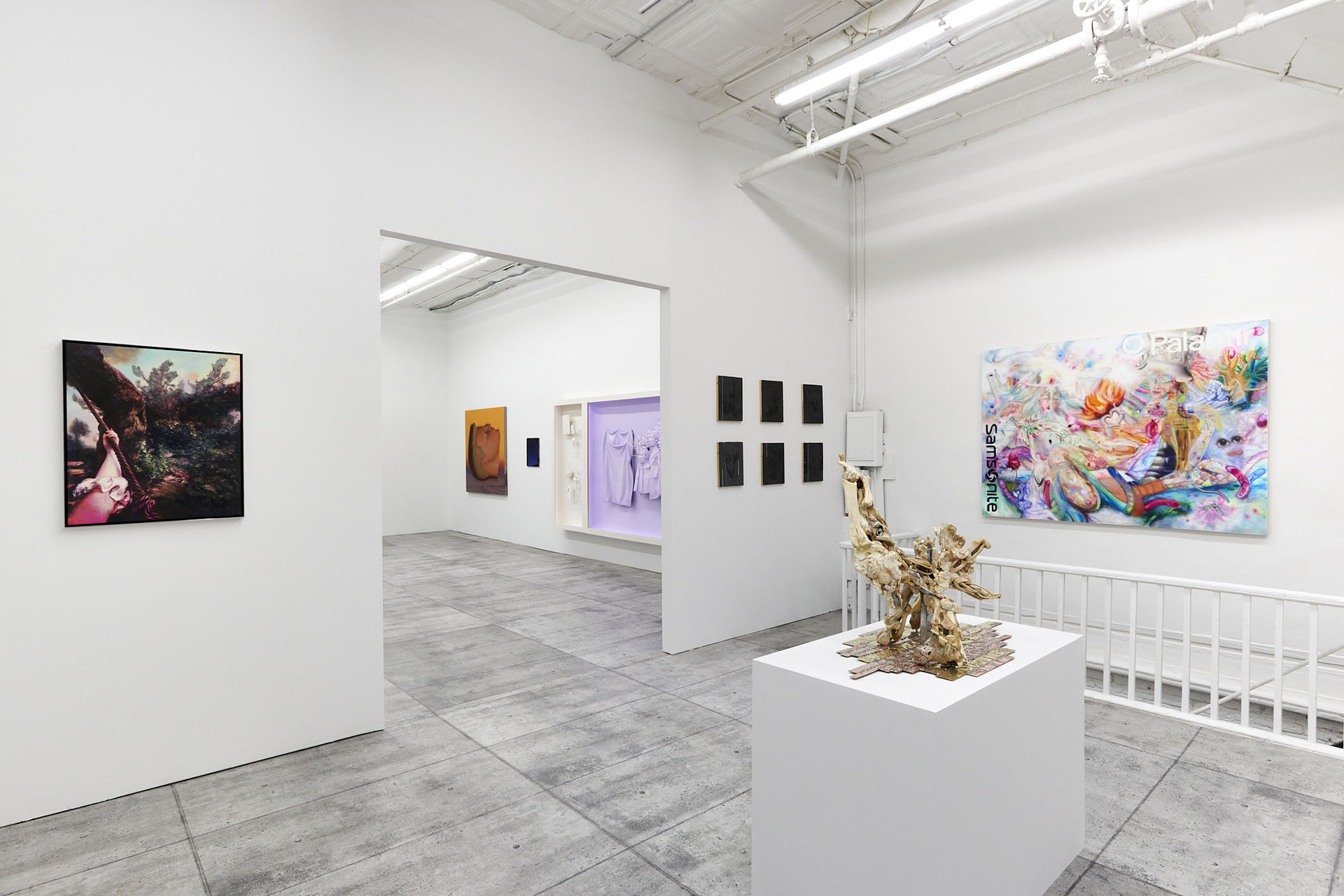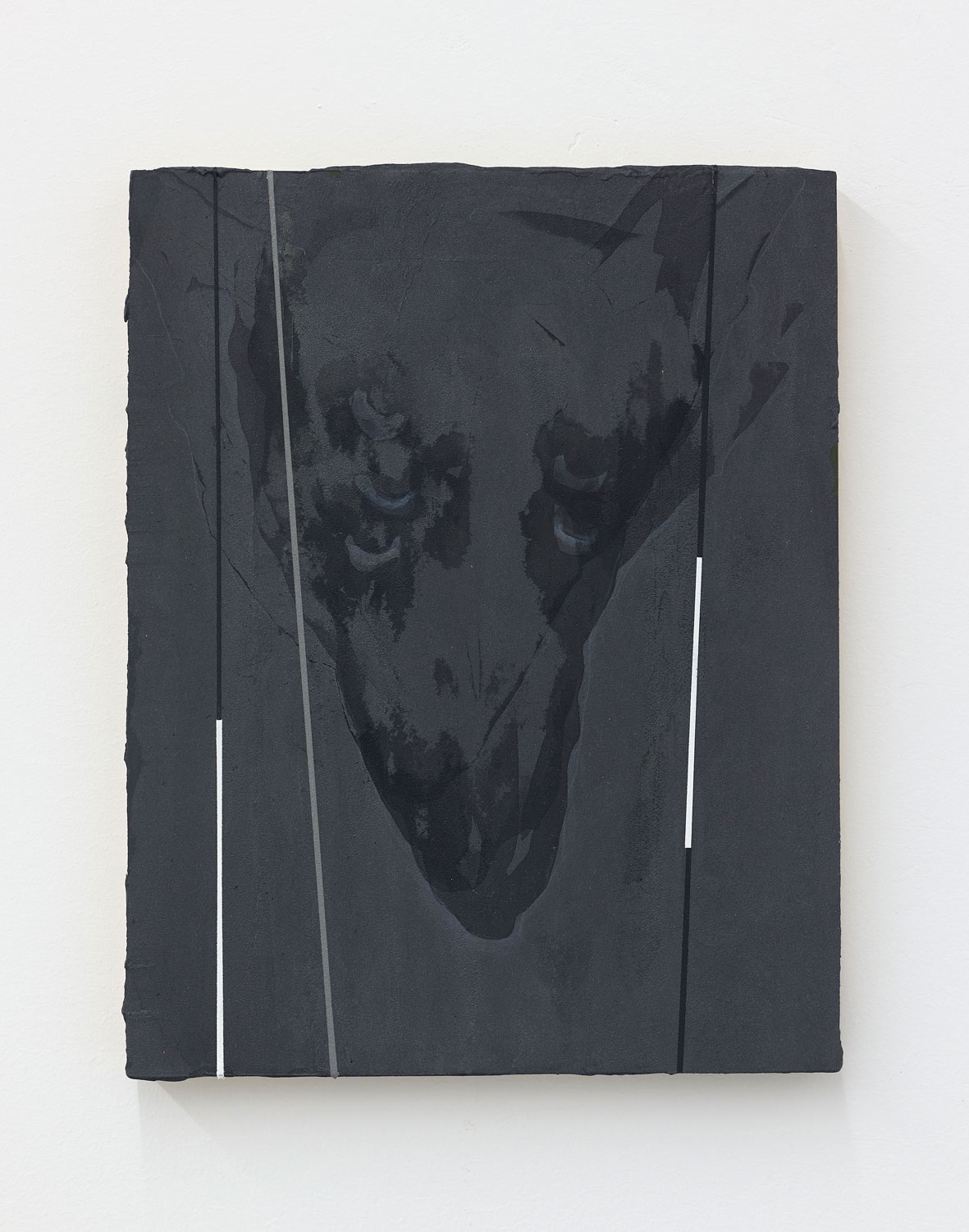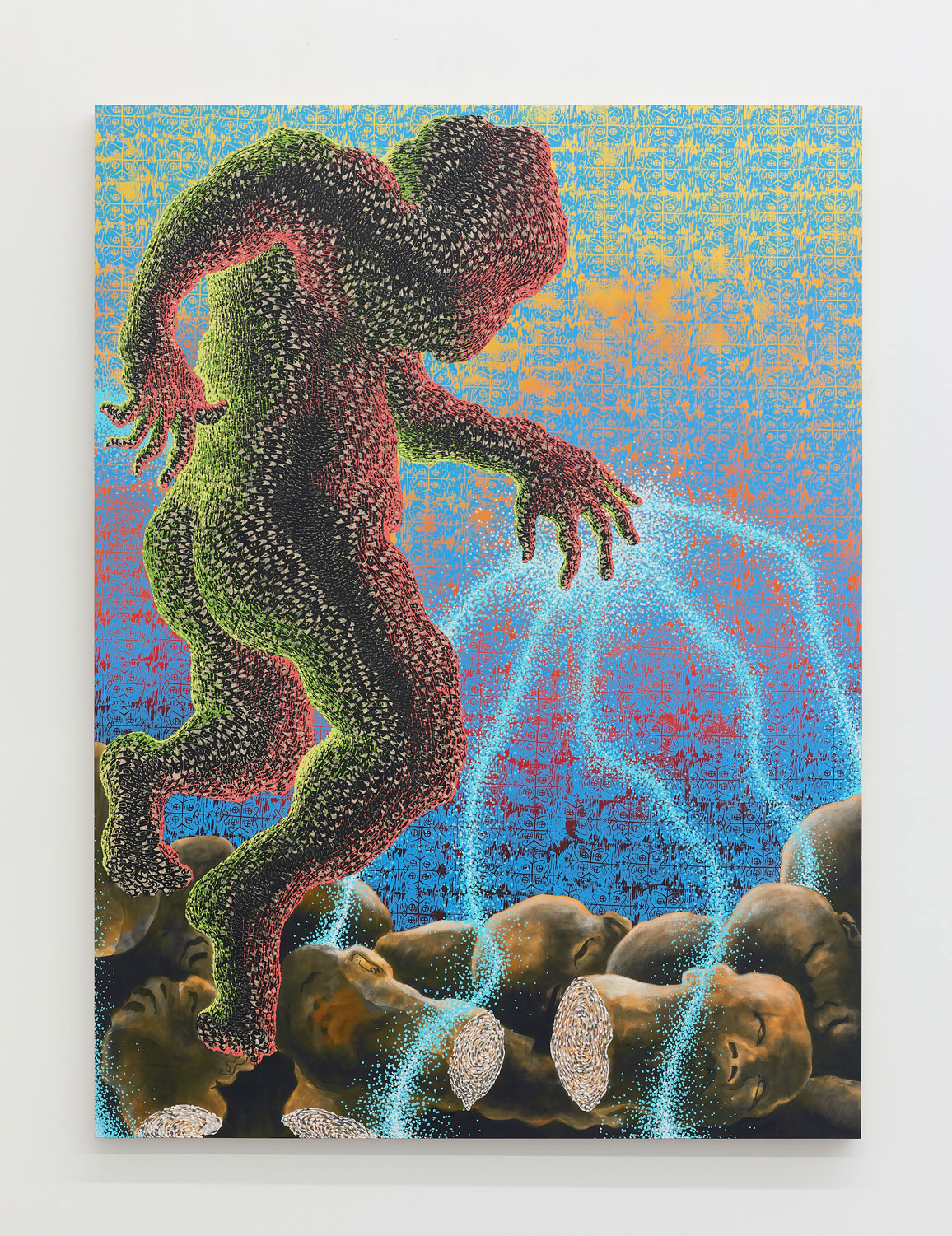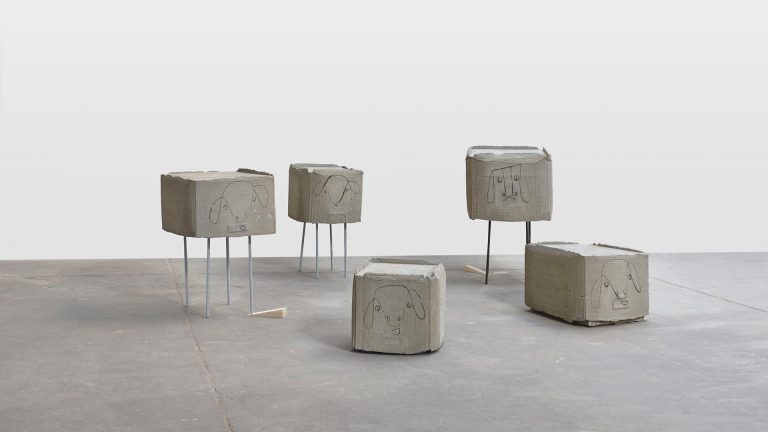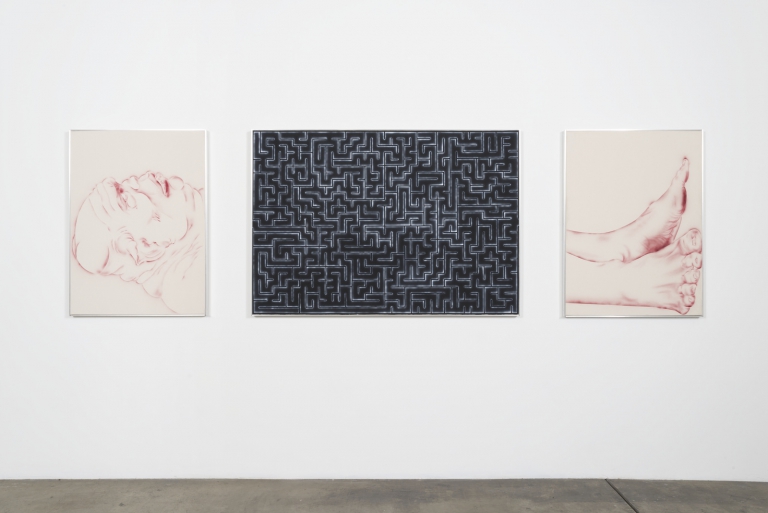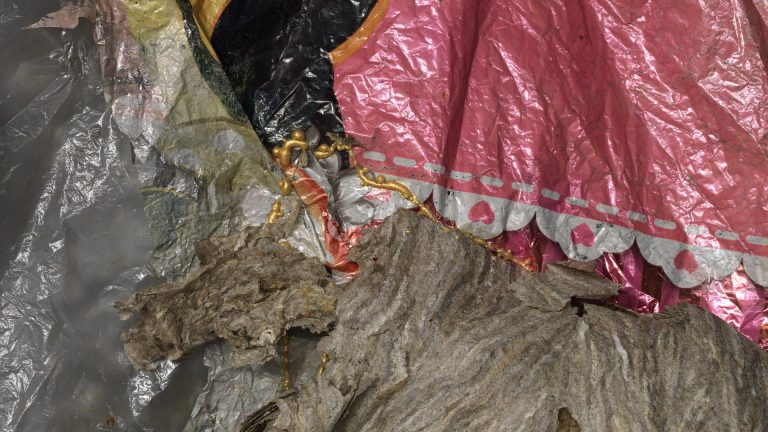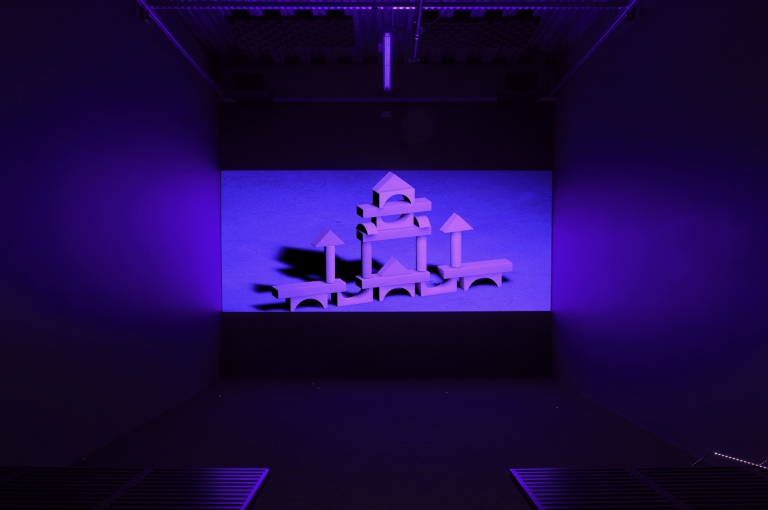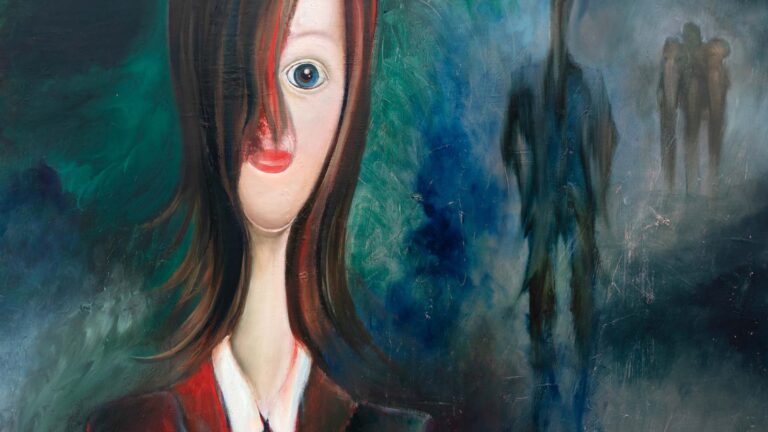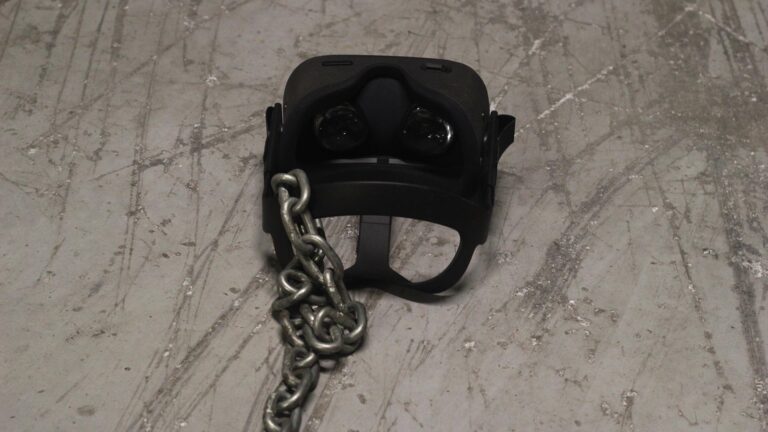Artists: Peggy Ahwesh, Claudia Bitran, Geoff Chadsey, Caitlin Cherry, Chris Coy, Carl D’Alvia, Du Jingze, Angela Dufresne, Mala Iqbal, Terrance James Jr., William E. Jones, Yasue Maetake, Michael Jones McKean, Nicole Miller, Joiri Minaya, Katharina Olschbaur, Carol Rama, Michael Robinson, Duane Slick, Emma Stern, Didier William, Andrew Woolbright, Sun Yitian, Cajsa von Zeipel
Exhibition title: Density Betrays Us
Curated by: Andrew Woolbright, Angela Dufresne, Melissa Ragona
Venue: The Hole, New York, US
Date: June 29 – August 15, 2021
Photography: images copyright and courtesy of the artists and The Hole, New York
The body has entered a realm of endless modification and anonymity—producing endless persona, worlds of saved games and respawn points. The works featured in Density Betrays Us conflate and confound figure and ground, individual and mass, weight and weightlessness, and visual and non-visual elements and events. Less interested in skin as an organ, than as an image-average, this exhibition excavates how surface—as force, as affect— is activated across several contemporary projects. To borrow from Gilles Deleuze, Spinoza’s idea of “spiritual automata” was a convincing way to present “our power of acting or force of existing.” The latter exists, he argues, in a continuous line of variation. The complex surfaces and body-oriented works of this exhibition embrace such dissimilitude, cutting across the incongruities of mediated translations.
As initially articulated in Woolbright’s “Phantom Body: Weightless bodies, Avatars, and the End of Skin” the body, specifically its canonical depiction as flesh, is being re-imagined in post-humanist terms.* Many contemporary artists represented here have left the physical body behind and exchanged it for variable virtual models. Emma Stern downloads open-source 3D models of young girls, overtly sexualized by their anonymous designers. Stern takes these models and attempts to give them personhood, naming them and introducing them into invented environments. At times they are chimeric —as in the work of Carl D’Alvia and Chris Coy—integrating animals and objects into their own 3D skin in a way that is in line with Donna Haraway’s concept of a Cyborgian hybrid being. Similarly, there is Didier William, who is using paint to reinvestigate what seems like the glistening, weightless environmental landscapes of early World of Warcraft games. Their low-res limitations are transformed by the material sensations created from dripping paint over carved wood panels- treated with such gravitas, detail, and commitment that we are forced to consider them as organic and social realities rather than as ephemeral effects.
Density Betrays Us also presents artists who explore the figure dematerializing in or folding into the landscape (and vice versa), as in the work of Joiri Minaya, Peggy Ahwesh, Sun Yitian, William E. Jones and Michael Robinson. Starting back as early as William Blake, who wanted his figures to appear hollow to advance his concepts of ecology or moving forward to Jacob Lawrence who tracked black bodies in transit—joined through kinetic color, moving, seemingly without conventional density—through a racist, troubled landscape, the artists presented here create spaces where figure and ground are sometimes grafted to each other, at other times, interdependent, but almost always— in constant motion. The background and foreground of Angela Dufresne’s work shimmer, undulate, forming phenomenological meshes. Figuration is developed by the negative space it inhabits. The figures and landscapes are at times indecipherable, ecological; creating an electric force that charges the surfaces of her paintings. Or Nicole Miller’s video work which highlights the physical effects of social and political realities, while operating as portals for escape, invocation and revelry. Caitlin Cherry similarly shows a body affected by its environment, and her work floats between the sensual body and the sonic as she flexes her expert handling of color, camouflage, as well as, visual and social noise.
Finally, we must remember that the term “digital” was already used in the 15th century. It referred to calculations or “cuts” that could be done using ten fingers, a knowledge understood at the edges of one’s body. In step with earlier innovations, we have included a master of corporeal intensities, the great Italian artist Carol Rama (1918-2015). Her work builds on, but moves beyond realistic representations of the body, or to borrow from Paul Preciado, she “irreverently incorporates a visceral, bodily sensibility into the history of modern painting, while injecting industrial and profane implications into its scope.” As avatars, chimeras, as kinetic force fields, the works in this exhibition challenge conventional notions of figurative art, tied as it is to positivist ideas about presence, subjectivity, and materiality. The work of these artists rejects canonical, patriarchal histories of portraiture, reaching beyond representations of a neo-liberal subject into worlds where bodies become open systems of affect, gateways to new technological forms of being-in-the-world.
Density Betrays Us, 2021, exhibition view, The Hole, New York
Density Betrays Us, 2021, exhibition view, The Hole, New York
Density Betrays Us, 2021, exhibition view, The Hole, New York
Density Betrays Us, 2021, exhibition view, The Hole, New York
Density Betrays Us, 2021, exhibition view, The Hole, New York
Density Betrays Us, 2021, exhibition view, The Hole, New York
Density Betrays Us, 2021, exhibition view, The Hole, New York
Density Betrays Us, 2021, exhibition view, The Hole, New York
Density Betrays Us, 2021, exhibition view, The Hole, New York
Density Betrays Us, 2021, exhibition view, The Hole, New York
Density Betrays Us, 2021, exhibition view, The Hole, New York
Density Betrays Us, 2021, exhibition view, The Hole, New York
Density Betrays Us, 2021, exhibition view, The Hole, New York
Density Betrays Us, 2021, exhibition view, The Hole, New York
Density Betrays Us, 2021, exhibition view, The Hole, New York
Density Betrays Us, 2021, exhibition view, The Hole, New York
Density Betrays Us, 2021, exhibition view, The Hole, New York
Density Betrays Us, 2021, exhibition view, The Hole, New York
Density Betrays Us, 2021, exhibition view, The Hole, New York
Density Betrays Us, 2021, exhibition view, The Hole, New York
Density Betrays Us, 2021, exhibition view, The Hole, New York
Density Betrays Us, 2021, exhibition view, The Hole, New York
Density Betrays Us, 2021, exhibition view, The Hole, New York
Katherina Olschbaur, The Ecstasy of St. Katherine, 2021. Oil on canvas, 79 x 79 inches, 200 x 200 cm
Claudia Bitran, Be Drunk, 2020. 31 painting animations in loop on SD card + TV monitor + Media Player, TV dimensions: 13.5 x 15 x 14.5 inches, 34 x 38 x 37 cm, Base: 42 x 18 x 18 inches, 107 x 46 x 46 cm, 1 minute 40 seconds.
Geoff Chadsey, Goat Twister 1 and 2, 2021. Watercolour pencil, crayon, pastel and fixative on mylar, Each: 66 x 42 inches, 168 x 107 cm.
Chris Coy, Wilma’s Rainbow 1, 2016. Oil on canvas, 30 x 24 inches, 76 x 61 cm
Duane Slick, Twilight Doppelgänger, 2018. Acrylic on panel, 14 x 11 inches, 36 x 28 cm
Duane Slick, Quiet Encounter, 2019. Acrylic on panel, 14 x 11 inches, 36 x 28 cm
Duane Slick, Coyote and the Tall Grass, 2019. Acrylic on panel, 14 x 11 inches, 36 x 28 cm
Andrew Woolbright, Digital Medieval Tenderness (Untergang simping for e-bois and e-girls), 2021. Oil and acrylic on canvas, 54 x 72 inches, 137 x 183 cm
Didier William, Koupe tet, Boule Kay, 2021. Acrylic, oil, ink, wood carving on canvas, 70 x 52 inches, 178 x 132 cm
Angela Dufresne, No Longer the Hazardous Forest, 2018. Oil on canvas, 83 x 132 inches, 211 x 335 cm
Caitlin Cherry, Rainroad, 2021. Oil on canvas, 57.5 x 58 inches, 146 x 147 cm
Yitian Sun, Ken, 2021. Acrylic on canvas, Left: 59 x 59 inches, 150 x 150 cm, Right: 18 x 15 inches, 46 x 38 cm
Michael Jones McKean, 15 Families, 2015. Wood, paint, urethane, lighting, brass, stainless steel, fossils, meteorites, shells, elements, bristlecone pine, 74 in x 133 x 8 inches, 188 x 338 x 20 cm
Emma Stern, Heather, 2020. Oil on canvas, 40 x 34 inches, 102 x 86 cm
Yasue Maetake, Lineal Fetishism II, 2020. Assorted animal bones, seashells, bronze, steel, brass, found stone, polyester resin, synthetic clay, 22 x 29 x 14 inches, 56 x 74 x 36 cm
Joiri Minaya, Emergence I, 2021. Archival pigment print on Hahnemühle paper, 60 x 40 inches, 152 x 102 cm
Carl D’Alvia, Forunato, 2016. Marble, 19 x 25 x 14 inches, 48 x 64 x 36 cm
Peggy Ahwesh, Rip Van Winkle, 2020. 4k 360-degree video, color, sound, 3 minutes and 4 seconds
Jingze Du, Brad, 2021. Oil on canvas, 23.5 x 20 inches, 60 x 50 cm
Casja Von Zeipel, Friends of Grapefruit, 2020. Pigmented silicon, Aqua resin, fishing flies, plastic plants, aquarium plants, curly shoelace, canoe paddle, muscle hook, “New York” sun protection hat, neon green camelbak, car window phone holder, arrow thing, “Pumpkins for Peace” pin, “Hot girl vs tiger” lenticular, key board, book, paint bucket tool belt, camouflage fabrics, pixel printed fabrics, camouflage dog vest, Minnewaska State Park Trail band, iPhone case, “Do you hate Grapefruit or just feel natural about them? Need quick answer” text message, synthetic hair, glass eyes, fish flies lashes, earrings, neon mesh thongs, flugsmällare, yellow pool floatie, barb wire sock, sesame seeds, “February” sign, wood incense, Slate Ultra soft blanket, pillow stuffing, iwatch case, mini speaker, MDF, fiberglass, and foam spray, 71 x 43 x 43 inches, 180 x 109 x 109 cm
Mala Iqbal, Leftover Part Witch, 2021. Oil on canvas, 46 x 45 inches, 117 x 114 cm
William E. Jones, What Have You Been Doing, 2020. High-definition video, 3 minutes, 46 seconds
Yasue Maetake, Pedigree of Industrial Bouquets, 2016. Polyurethane resin, steel, brass, copper, paper, oil paint, 32 x 27 x 38 inches, 81 x 69 x 97 cm
Nicole Miller, The Borrowers, 2014. Digital video: 16 minutes and 52 seconds
Terrance James, Phlegm, 2020. PVA Glue, expanded polystrene (EPS) head, PVS tubing, steel, sumi ink, dye, Head: 10 x 7 x 8 inches, 25 x 18 x 20 cm, Steel base: 24 x 3.5 x 3.5 inches, 61 x 9 cm
Terrance James, Photogenesis, 2019-2020. PVA Glue, Expanded Polystrene (EPS) Head, PU and PVS tubing, steel, Sumi ink, dye, acrylic, Head: 15 x 9 x 7 inches, 38 x 23 x 18 cm, Steel base: 24 x 3.5 x 3.5 inches, 61 x 9 x 9 cm




